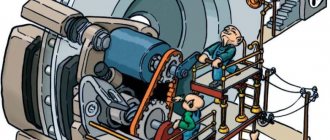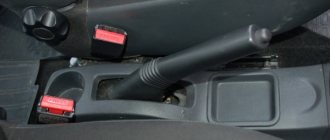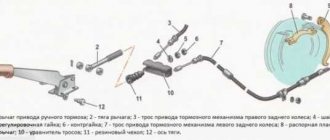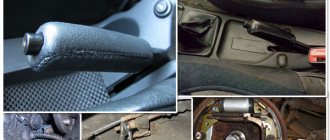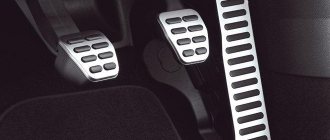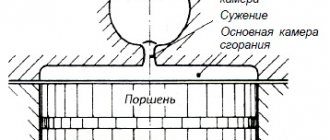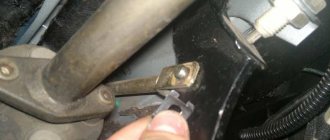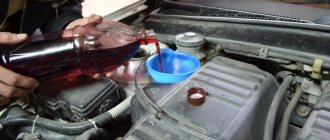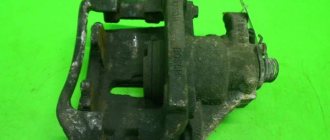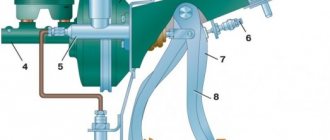Regular driving through puddles and water, combined with low temperatures, can lead to moisture accumulation in areas where its presence is not welcome. One such location is the parking brake assembly.
It cannot be said that the handbrake freezes very often and this happens everywhere. But the possibility of such a situation should not be ruled out. Especially at low air temperatures, which are typical specifically for the winter period of vehicle operation.
It is important for a motorist to understand why the parking brake on his car may freeze and how to get out of this situation.
Reasons for freezing
Some motorists are not at all sure whether the handbrake can freeze in practice and why this even happens. In fact, you shouldn’t be surprised by this fact. Freezing is typical for any car, regardless of the make, model or year of manufacture.
Here it is more important to understand why exactly the handbrake on a car freezes, as well as how to deal with it. The situation is quite paradoxical, since automakers have always strived to provide the most effective ventilation for the brake discs and drums on the car. Thorough airflow helps cooling. But when frost hits and humidity rises, settling moisture begins to accumulate and form an ice crust on surfaces.
At the same time, moisture accumulates in hidden cavities that are located at a certain distance from the ventilated space. This also includes the hand brake assembly. Water accumulates especially actively when it acquires various states of aggregation, turning from liquid to vapor, and then becoming liquid again.
Moisture will accumulate gradually, filling the space and causing the handbrake to freeze. After washing in winter, it is recommended to blow out the brake system and handbrake assembly using hot air. But not everyone does this. The settled moisture turns into an ice crust, and when the handbrake is turned on, within a few hours it can stick tightly to the brake elements of the wheels.
Wheels can become blocked for several main reasons:
- the brake pad freezes to the surface of the drum or brake disc, depending on the design of the car;
- the brake cable freezes on the side of the outer shell when the handbrake is turned on;
- jamming occurs that is not associated with freezing.
Here it is important to distinguish freezing from jamming. The latter happens in any weather, that is, it can happen in summer and winter. But freezing is typical exclusively for the winter period, when there is sub-zero temperature outside with high humidity.
To accurately determine the malfunction, you need to dismantle the wheels, remove brake pads and drums or discs, inspect the area, etc. But usually there is no time for such manipulations. In some conditions, the problem must be solved in a maximum of an hour.
In reality, everything happens quite simply in the daily life of a motorist. He drives through puddles or visits a car wash. Arriving home and turning on the handbrake, the moisture crystallizes, turning into a dense ice crust. She does not allow the handbrake to be released because it is frozen. Moreover, huge volumes of moisture are not required here.
Frozen car handbrake cable
It is impossible to say exactly at what temperature the handbrake gradually freezes. The process definitely begins to develop when the temperature drops below 0 degrees Celsius. But often we are talking about more serious frosts, from about 5-10 degrees below zero or less. Then the frozen device does not come off by simply lowering the brake, if the car is equipped with a classic handbrake with a mechanical drive. The situation with the electronic handbrake is even more complicated.
But if everything is quite clear with the brake pads, since they are located outside, then the issue of freezing of the handbrake cable causes confusion among many. When the machine comes into contact with water and moisture, copious amounts of fumes are generated. Especially after starting to move, when the car heats up, the water evaporates and turns into steam. But when it stops, the condensation process resumes and the steam becomes water again.
As it cools, condensation affects components with high thermal conductivities. The end of the handbrake cable is located outside the car body, and therefore it is the one that begins to cool first. This is where the process leading to the formation of ice begins.
The end of the handbrake cable gradually attracts moisture towards itself, and it already ends up in the cable channel. In this far from cunning way, he freezes.
Next, you need to understand what needs to be done by a driver who has put his car on the handbrake, and the brake pads suddenly froze. Be sure to put yourself in a similar position, since this situation is possible for everyone. It is better to be prepared in advance and have several effective means to eliminate the problem of freezing handbrake.
Why and how moisture remains in the brake mechanism in the garage
Our old men - “kopeks”, “Muscovites” and “Cossacks” did not suffer much from such problems. I talked to many drivers - there were enough problems with the brakes, but it never happened that the brake froze in the parking lot. They tried to store the car in a draft, or rather even a draft - a subtle movement of air in the garage. If there was severe frost, the car sometimes froze to the ice. Such a breeze dried and ventilated all the cavities of the car, the cars could sit in the garage for years without anti-corrosion treatment and almost did not rust. The handbrake froze only in exceptional cases.
How does water get into the handbrake channel?
Water or water condensation will inevitably accumulate in closed, poorly ventilated areas. At low partial pressure of water vapor in cold conditions, moisture seems to stick to the surface of the metal and eat into its pores. Unstable state from 0 to +7оС. In this temperature range, water precipitates into fog and condenses on any metal. Including on brake pads, whose structure strongly resembles a sponge with a microporous structure.
We washed the car, parked it on the stand and blew out the door and trunk locks. It is difficult to play it safe for a manual drive so as not to freeze. It's hard to get to the mechanism. At low temperatures, you can remove the water film from the surface of the parts by intensively blowing hot and dry air, not necessarily even hot, but dry. To prevent the handbrake from freezing, this procedure must be done regularly.
After washing, the car interior is also full of water vapor. As the car cools down in the cold, moisture will condense on objects with high thermal conductivity. The end of the cable, attached to the outside of the body, cools down the fastest and, like a wick, draws in moisture that accumulates in the cable channel. As a result, the handbrake cable froze. Smart guys installed two rubber caps that fit on both sides of the cable. They were supposed to prevent any penetration of the manual drive cable into the channel, but for some reason this does not work. As a result, the hand parking brake freezes. The moisture, turning into ice crystals, tightly jams the cable. More and more people are starting to watch Russian sex on the Internet, abandoning foreign resources and often completely switching to our website, where you can always find a video to your liking. Still, it was not in vain that the girls tried, knowing that the link leads to a Russian porn site, where anyone who wants to or simply follows the link can watch close-up how they are fucked in a variety of holes. Moreover, this is done specifically on camera, but sex never ceases to be intimate and truly passionate.
Recipe one
In order to prevent a situation where the manual drive cable freezes, it is necessary to dry the car with an air flow, and not with temperature. Therefore, to prevent unpleasant situations, first of all, organize proper supply and exhaust ventilation, preferably without the use of electric fans or other mechanization.
Recipe two
It is easier to prevent the situation than to deal with it when the brake is already frozen. Remember the last time the handbrake cable was removed and serviced: probably, like everyone else, never. For normal operation of the machine, a working hand brake is an extremely necessary thing. Therefore, it is worth removing the old mess of oil, dust and condensation, replacing it with new lubricant, it is advisable not to use grease or graphite lubricant.
Recipe three
The irreplaceable composition VD40, in addition to its high penetrating ability, has a number of disadvantages. But, after using the VD-shki, the metal surface becomes oily, which collects dust and serves as an excellent environment for the accumulation of condensation. Therefore, if the handbrake freezes, it is better to use pure alcohol. Using a medical syringe, it can be injected into any microscopic hole in a frozen mechanism. Efficiency is many times higher. It is worth remembering that aviation has always successfully combated icing with alcohol. A pharmaceutical bottle with medical alcohol and a syringe - and the problem of how to defrost the handbrake will be solved.
Recipe four
If the manual drive is still frozen, you can correct the situation with an open fire. This is best done using a miniature gas burner based on a cartridge cylinder or a homemade torch made from rags and 50g of motor oil. To do this you will have to:
- remove the wheel;
- get to the place where the section of the manual drive cable is frozen to the metal;
- direct the flame of the burner or torch to the open part of the cable or brake pad.
It is almost impossible to overheat them in frosty weather, but it is advisable not to overuse the heat, as rubber hoses or cuffs can be damaged, and the gas tank is nearby - it is better not to take any unnecessary risks.
The video clearly shows how to defrost the parking brake:
- Contact ignition system - operating principle
- How to apply liquid, solid, hot, cold wax to your car
- Why disable ABS on a car?
- Biodiesel at home
Priority actions
First, you need to eliminate the possibility that the brake pedal is simply stuck. This already indicates mechanical faults not related to freezing. If the handbrake itself is simply frozen, then you can deal with the situation using several methods.
It cannot be said that jamming due to icing of the brake assembly is a regular and extremely common occurrence. Handbrake brakes usually jam if they have previously encountered a large amount of moisture, driven through puddles, or used a car wash. It is difficult to notice water freezing near the brakes. And few people pay attention to this. No one could even think that something like this would happen to him.
But still, you shouldn’t rule out the possibility of brake pads freezing. There are too many factors that provoke such phenomena. Plus, the harsh climate forces Russian drivers to be more attentive to the condition of the brake unit.
First of all, think about the means at hand that can help in the current situation. Almost anything that has a temperature higher than the ambient temperature will do. Often motorists, while in the field, use gasoline. Some even warm up the brake system components using open fire. Although this option is not welcome due to too great risks.
The handbrake is frozen, how to solve the problem
Usually the handbrake freezes after a collision with water, while driving or visiting a car wash. Then leaving the car temporarily on the parking brake. The machine will not be transportable; you will have to use improvised mechanisms and means.
Any solution that has a higher temperature than the ambient temperature at the moment can help.
You can try to warm up the brake pads by holding a lit piece of paper to an icy surface. With this method you need to be very careful not to bring the burning paper too close. This method is not recommended due to its unreliability from a safety point of view.
And when solving the issue, one thing is obvious: you should not forcibly tear off the frozen pads using the car engine - you need to act measuredly and carefully.
Defrosting methods
If you live in a region with fairly harsh and cold winters, at least one of the products presented below must be present in your car when the weather gets colder.
No one can predict whether your brake pads will freeze or not. The behavior of the handbrake is sometimes unpredictable. For some people, even in deep minus conditions outside, everything works fine. For another motorist, even at -4 degrees Celsius, the brake may jam due to accumulated moisture, and it becomes impossible to move without damaging the brake assembly.
There are several effective remedies for those who do not know what to do if the handbrake is frozen. You can cope with this situation with the help of:
- defrost;
- alcohol-containing substances;
- hot water;
- construction hair dryer.
It is better to put aside the option of using open fire. It is used only in the most emergency situations, when it is not possible to use safer means.
Using defrosters
This is a special tool that helps in solving emergency problems related specifically to the freezing of various mechanisms, locks, etc. They were created not only for use on cars. Defrosters are perfect for those who need to open a barn lock, use a key to get into the cylinder of the locking mechanism, and remove ice that has formed from various devices and mechanisms.
Each manufacturer has its own special composition, which is not always available in the public domain. In fact, it is a solution offered primarily as an aerosol spray. It contains components that help defrost ice. Moreover, the drug can reach quite hard-to-reach places.
If you often operate your car in winter and regularly use the handbrake in sub-zero temperatures, the likelihood of it freezing is quite high. Therefore, it definitely wouldn’t hurt to get a can of defroster for this period. It takes up minimal space in the trunk, but can help out in a difficult situation.
If you have a defroster, you will know exactly what to do if the handbrake pads are frozen to the brake discs or drums on your vehicle.
Using fluid to defrost handbrake pads
Liquids containing alcohol
As previously noted, the handbrake freezes equally often on both disc and drum brakes. The type of brake unit does not play a key role in this matter.
If you don’t have a defrost at hand, there is an alternative option to cope with the problem. A substance that contains alcohol and does not freeze at subzero temperatures, as happens with ordinary water, will help you.
These liquids include fuel, regular technical or medical alcohol, and window cleaners. They contain alcohols, which allows them to cope with ice quite effectively.
Surely at least something from the presented list is in your car. Almost every motorist carries with him a container for washing windows and glass, since such a liquid can be useful on the road. There are also ways to drain small amounts of fuel. There are doubts about pure alcohol, but if you are near a pharmacy, the problem is also easily solved.
The essence of using such liquids is extremely simple. They need to be applied to the pads and wait a while. Do not forget that alcohol is highly flammable. Therefore, you should not illuminate your brake assembly when applying alcohol-containing liquid with some open flame source. Otherwise, accidental fire may occur.
At the same time, alcohol-containing liquids are highly effective. They dissolve the ice, which allows you to remove the car from the handbrake and go about your business. These products do not cause any harm to pads, discs and drums.
Water
Since not only the pads of a car parking handbrake can freeze, but also the handbrake cable, which is not so easy to reach, it is important to understand what to do in such a situation and what means can help if the components are frozen.
Some will be surprised, but you can use ordinary water. This is another example of a fairly effective means that allows you to freeze the parking brake pad, as well as treat the frozen cable of a problematic handbrake. The advantage is that you don’t have to save water.
Only an important amendment should be made immediately. In extreme cold, you should never use boiling water. This will be detrimental to the car, paintwork, metal, etc. It is too dangerous to use boiling water at a temperature of about 100 degrees Celsius. But there will be no damage from just hot water. Therefore, water is considered one of the safest and least aggressive methods of combating freezing of the handbrake pad and cable.
It is unlikely that anyone will have difficulty pouring hot water over frozen parts. But here it is important not to wait until the opposite effect occurs and the brakes begin to become covered with an icy crust again. This is exactly what will happen if you remain in place after the nodes have thawed. It is important to move off immediately in order to develop the knot and prevent ice from appearing again.
What to do?
First of all, you should make sure that the problem lies specifically in the handbrake, since it may not move for other reasons. Next, you should raise and lower the lever several times; if the manipulations do not lead to anything, then you need to move on to the next steps. You can try using boiling water, which should be poured into a kettle. Pour liquid over the brake drums, and after the wheels start moving, be sure to dry them using sharp braking using the handbrake.
This is the fastest way to get rid of the existing problem. If this idea does not cause delight, then it is necessary to supply gases emitted by the machine to the frozen brakes. For this purpose, a hose is used, one end is attached to the gas exhaust pipe, and the other is directed to the frozen part.
This will require a lot of time, and you will also have to be patient. There are also easier methods:
- Use a heat gun or hair dryer; a gas burner will also work. Direct hot air onto the icy part and wait until it defrosts completely.
- If there are no available means nearby, then you can use a regular block of wood and tap it on the brake drums. Sometimes this helps get rid of the ice crust.
- It would be quite reasonable to use special liquids that are suitable for defrosting locks. But to do this, you will need to lift the car with a jack and remove the wheels, since it is not such an easy task to get to the brake drums.
